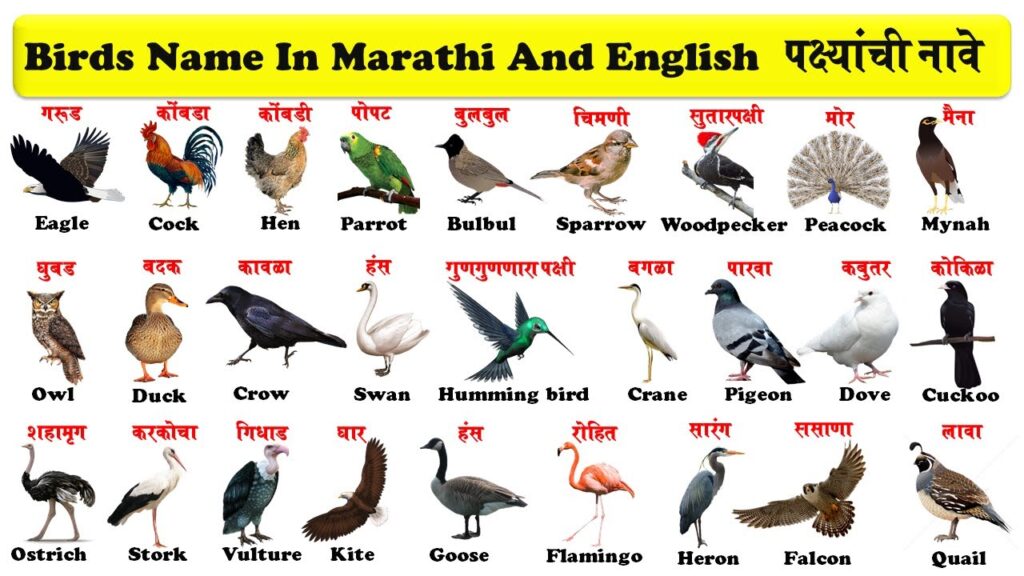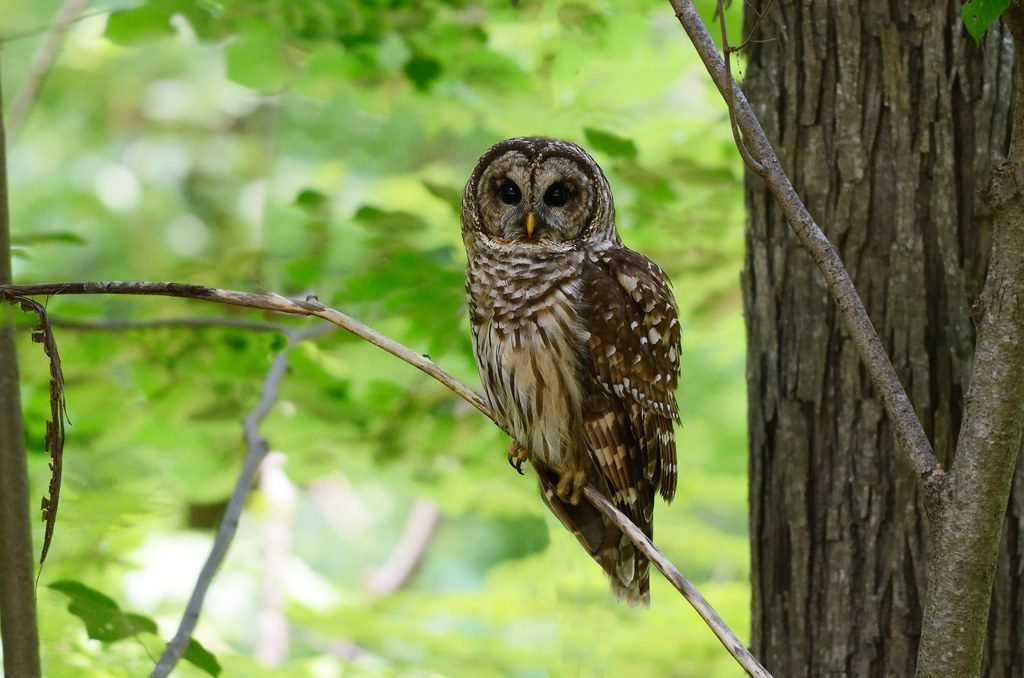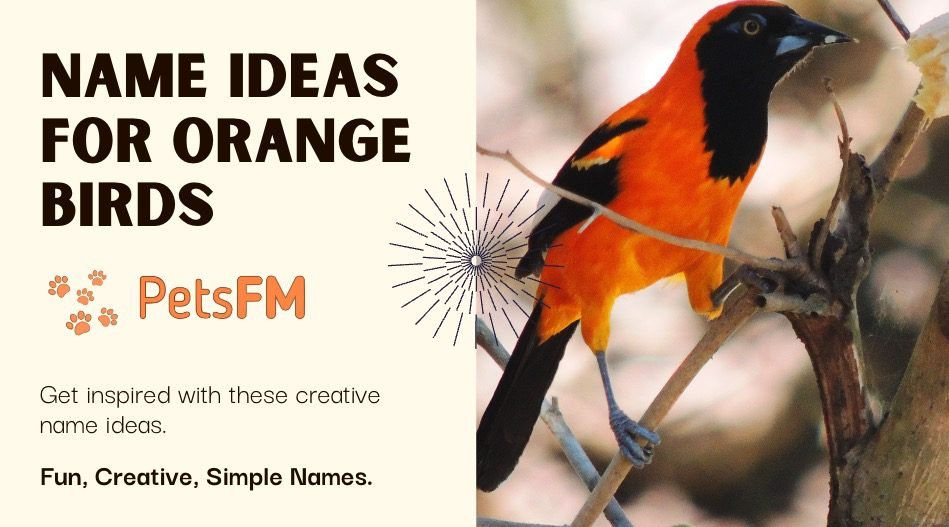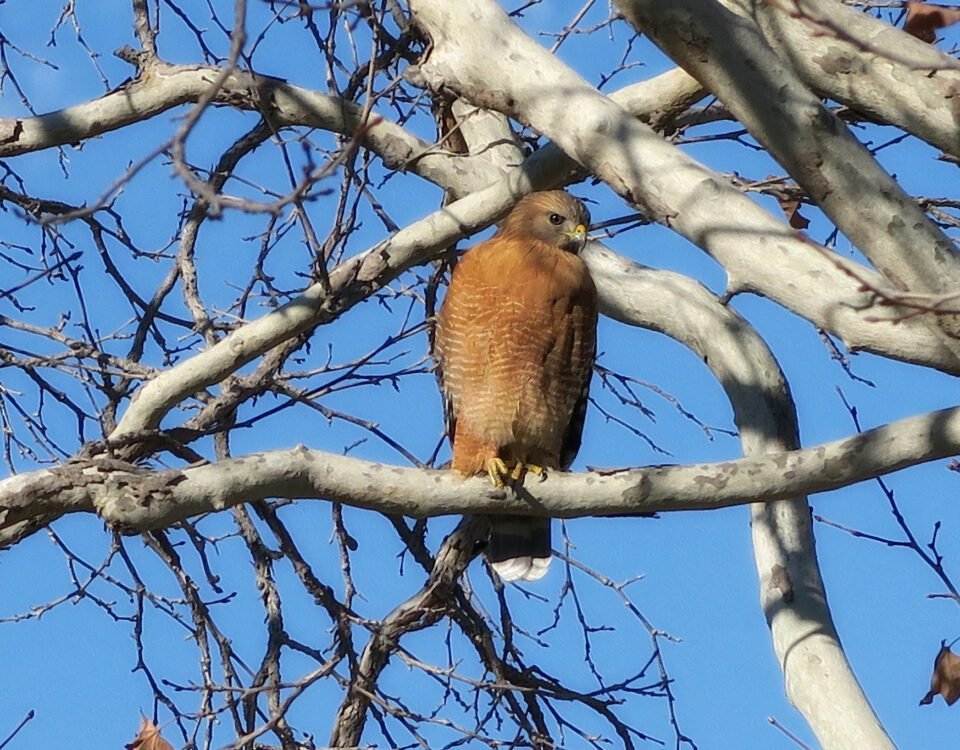


100+ Bird Names In Sanskrit With Translation in English
December 31, 2023


4 Reasons Why Quaker Parrots are Illegal in 12 States of the US
December 31, 2023Marathi, a language steeped in cultural and historical significance, deeply connects with India’s diverse heritage, much like Sanskrit. This article explores the Marathi names for various birds, offering translations into English and exploring their cultural and symbolic meanings within Marathi traditions.
These birds, celebrated for their vibrant plumage and melodic songs, are appreciated for their aesthetic appeal and hold a special place in Marathi literature and folklore for their symbolic resonance.


Bird Names in Marathi and English
100 Bird Names In Marathi
1: Chimb (Sparrow)
In Marathi culture, the Chimb (sparrow) is admired for its delightful songs, symbolizing joy and the charm of simplicity, echoing through villages and cities alike.
2: Mor (Peacock)
The Mor (peacock), a symbol of beauty and spirituality in Marathi tradition, captivates with its colorful feathers, representing elegance and the vibrancy of life.


Violette Peacock
3: Parvat (Pigeon)
Commonly seen in gardens and urban spaces, the Parvat (pigeon) in Marathi lore signifies tranquility and harmony, embodying peace and unity.
4: Kavala (Crow)
Present in diverse environments, the Kavala (crow) in Marathi culture indicates intelligence and versatility, thriving in urban and rural settings.
5: Popat (Parrot)
Famous for their bright colors and mimicry, Popat (parrots) are treasured in Marathi tradition, representing the liveliness and conversation of daily life.
Also, Read: Why Does My Parrot Lunge At Me? Specific Parrot Species Guide
6: Garud (Eagle)
Majestic and formidable, the Garud (eagle) in Marathi mythology symbolizes strength and sharp vision and is respected as an emblem of power and spiritual insight.
7: Ghubad (Owl)
Shrouded in a nocturnal enigma, the Ghubad (owl), with its mystical presence, is often viewed as a symbol of wisdom and learning in Marathi literature.


Barred Owls
Also, Read: Can You Hunt Owls? Everything You Need to Know About Owl Hunting
8: Khandya (Kingfisher)
Known for its swiftness, Marathi culture’s Khandya (kingfisher) is recognized for its expert fishing skills, symbolizing precision and elegance.
9: Kaththaknath (Woodpecker)
The rhythmic pecking of the Kaththaknath (woodpecker) holds symbolic meaning in Marathi tradition, denoting the rhythm of nature and the energy of forest life.
10: Saras (Crane)
The Saras (crane), known for its elegant movements and harmonious mating dances, is celebrated in Marathi literature, symbolizing grace and companionship.
11: Hamsa (Duck)
Gliding gracefully on water, Marathi culture’s Hamsa (duck) represents serenity and beauty with its calm nature and soothing sounds.


Wood Ducks
12: Rajhans (Swan)
In Marathi mythology, the Rajhans (swan) stands for purity and allure, often appearing in romantic tales and legends, embodying spiritual grace.
13: Kokila (Cuckoo)
The melodious call of the Kokila (cuckoo) in Marathi tradition heralds the arrival of spring, bringing happiness and a sense of rejuvenation.
14: Saluki (Myna)
The Saluki (myna), commonly found in urban areas, is noted for its sociability and spirited nature in Marathi culture, symbolizing urban energy and communication.
15: Kapoti (Dove)
Symbolizing peace and tranquility, the soft cooing of the Kapoti (dove) in Marathi literature is calming, reflecting harmony and inner stillness.
16: Gidhad (Vulture)
In Marathi culture, Gidhad (vultures) are respected for their crucial ecological role, consuming carrion and thereby contributing to the cleanliness and balance of the environment.


Vulture
17: Bater (Quail)
Elusive and small, the Bater (quail) in Marathi tradition is recognized for its ability to blend with its environment and melodious calls, symbolizing subtlety and discretion.
18: Bahiri (Falcon)
The Bahiri (falcon) is esteemed in Marathi lore for its impressive flying abilities and hunting skills, representing speed, agility, and strategic precision.
19: Bagala (Heron)
Bagalas (herons), with their elegant stance, are often depicted in Marathi literature as poised and patient, standing motionless near water bodies, symbolizing contemplation and focus.
20: Pengvin (Penguin)
Adapted to colder climates, Pengvins (penguins) in Marathi tradition embody resilience and adaptability, noted for their graceful swimming despite their funny walking.


Adélie Penguin
21: Rajhans (Flamingo)
Rajhans (flamingos), with their striking pink hues and unique stances, symbolize beauty and distinctiveness in Marathi culture, commonly seen in marshy areas.
22: Sonchafa (Canary)
In Marathi tradition, Sonchafas (canaries) are celebrated for their bright plumage and melodic songs, symbolizing happiness and the beauty of sound.
23: Hummingbird (Hummingbird)
Hummingbirds in Marathi culture are admired for their rapid wing movements and ability to hover, representing agility and the fleeting beauty of nature.


Rufous Hummingbird
24: ShutarMurg (Ostrich)
ShutarMurgs (ostriches), known for their land speed and large size, represent strength and stamina in Marathi culture despite their inability to fly.
25: Ghariyal (Hawk)
In Marathi tradition, Ghariyals (hawks), with their sharp vision and soaring flight, symbolize the heights of observation and the precision of a skilled hunter.
26: Kavla (Magpie)
Kavlas (magpies), with their unique coloration and inquisitive nature, are seen in Marathi culture as symbols of intelligence and curiosity.
27: Kavala (Raven)
Larger than the common crow, Kavalas (ravens) in Marathi lore, with their deep calls, are often linked with mystical and wild aspects of nature.


Ravens at Night
28: Bater (Partridge)
Robust and melodious, Baters (partridges) in Marathi tradition symbolize rural life’s vitality and the countryside’s harmonious melodies.
29: PaniKokru (Pelican)
Known as PaniKokrus (pelicans) in Marathi culture, these birds are admired for their fishing skills, often seen scooping fish with their large throat pouches.
30: Chimb (Finch)
Chimbs (finches), small and colorful, are cherished in Marathi literature for their lively chirping, adding a joyful sound to the natural environment.
31: Patang (Kite)
Patangs, gracefully soaring in the Marathi skies, are known for their distinct V-shaped tails, often creating a striking silhouette against the backdrop of ancient cities.
32: Bhauri (Lark)
Celebrated in Marathi poetry, Bhauris (larks) enchant with their high, spiraling flights and melodic songs, inspiring artistic and musical creativity.
33: Ākāshpakshi (Swift)
Ākāshpakshis (swifts), renowned for their remarkable speed, spend most of their lives airborne, nesting high in the nooks of historic structures.
34: Kojagiri (Nightingale)
Immortalized in Marathi legend, Kojagiris (nightingales) captivate with their nocturnal melodies, adding a musical charm to tranquil nights.
35: Kokatoo (Cockatoo)
Native to distant lands but recognized in Marathi tradition, Kokatoos are noted for their striking crests and ability to mimic various sounds.
36: Samudra-pakshi (Albatross)
Samudra-pakshis (albatrosses), sovereigns of the seas, are revered for their extensive wingspans, allowing them to glide effortlessly over vast oceans, embodying the spirit of freedom and exploration in Marathi culture.
37: Nakshatrapakshi (Starling)
Nakshatrapakshis (starlings) are admired for their mesmerizing group flights, moving in large, coordinated patterns in the Marathi sky, symbolizing unity and coordination.
38: Jalakombdi (Moorhen)
Inhabiting the edges of water bodies, Jalakombdis (moorhens) in Marathi culture are recognized by their bright red bills and distinctive frontal shields, symbolizing adaptability to aquatic environments.
39: Kavla (Jackdaw)
Part of the crow family, Kavlas, with their distinctive silver-grey heads, are known for their playful and social nature in Marathi culture, representing communal living and intelligence.
40: Samudra-pakshi (Tern)
Samudra-pakshis (terns) exhibit exceptional sea hunting skills, diving with precision to capture fish, embodying efficiency and agility in the Marathi tradition.
41: Robin (Robin)
With their striking orange breasts, Robins holds a special place in many Marathi cultural narratives, often symbolizing the warmth and joy of winter celebrations.
42: Sagari (Seagull)
Sagaris (seagulls), recognized by their distinctive calls, are commonly found along coastlines and are adept at thriving in urban environments, representing adaptability and resilience.
43: Toṅkāra-pakshi (Toucan)
Toṅkāra-paksha (toucans), known for their large, colorful bills, are a vibrant spectacle in rainforests, symbolizing the vibrancy and diversity of nature in Marathi tradition.
44: Kombdi (Pheasant)
Kombdis (pheasants) are noted for their diverse and striking plumage, often associated with hunting and the regality of nature in Marathi culture.
45: Kuru (Ibis)
Respected since ancient times, Kurus (ibis) use their curved beaks for foraging in marshy lands, epitomizing adaptability and resilience in Marathi tradition, representing a connection with the natural world.
46: Rani (Rook)
In Marathi culture, Ranis (rooks), commonly seen in agricultural areas, are known for their bare-faced appearance and are celebrated for their strong sense of community and cooperation.
47: Rangitpakshi (Bunting)
Rangitpakshis (buntings) are small and melodious, charming with colorful feathers in Marathi lore, captivating nature lovers with their sweet songs.
48: PanyachaPakshi (Cormorant)
PanyachaPakshis (cormorants), recognized by their unique wing-drying stance, are skilled divers, symbolizing agility and precision in their aquatic hunting techniques.
49: Kolvadya (Curlew)
With their distinctive long, curved beaks, Kolvadyas (curlews) skillfully forage in marshlands, representing elegance and adaptability in Marathi tradition.
50: BarfaniPakshi (Grouse)
BarfaniPakshis (grouse), adapted to cold terrains, blend seamlessly into snowy landscapes, symbolizing the art of camouflage and survival in extreme conditions.
51: ChivChiv (Chiffchaff)
ChivChivs (chiffchaffs), known for their repetitive and lively tunes, enliven the tree canopies, adding a rhythmic layer to the natural soundscape.
52: SoneriPakshi (Goldfinch)
SoneriPakshis (goldfinches) add a splash of color to gardens with their striking plumage, contributing melodiously to the symphony of nature.
53: RatraBaksa (Barn Owl)
RatraBaksas (barn owls), often residing in old buildings, evoke a sense of mystery with their ghostly appearance and haunting calls at night.
54: Kudukudupakshi (Hoopoe)
Kudukudupakshis (hoopoes), with their distinctive crests and patterned feathers, probe the earth with their long beaks, symbolizing diligence and uniqueness.
55: MasaBhaksha (Osprey)
MasaBhakshas (ospreys), magnificent birds of prey, are known for their adept fishing skills and striking facial markings, symbolizing focus and determination.
56: Raktapayi (Chough)
Raktapayis (choughs), with their glossy black feathers and vivid red bills and legs, are often found in rugged terrains, embodying resilience and adaptability.
57: Dhanyapakshi (Wheatear)
Dhanyapakshis (wheatears) are noted for their quick tail flicks, creating a soothing visual rhythm akin to gentle waves in nature.
58: Gharpakshi (House Sparrow)
In urban settings, Gharpakshis (house sparrows) are integral to human habitation, symbolizing familiarity and the ability to adapt.
59: Bulbul (Bulbul)
Bulbuls, primarily from the East, are renowned for their musical voices in Marathi culture, inspiring artistic expressions and songs.
60: HasuPakshi (Laughing Dove)
HasuPakshis (laughing doves), with their continuous, chuckling coos, add a peaceful and joyful ambiance to mornings and evenings, symbolizing serenity and joy.
61: Nilkanth (Roller)
Perched loftily, Nilkanths (rollers) display a stunning mix of turquoise and brown, surveying their territories with regal poise in Marathi tradition.
62: Vanakabutar (Wood Pigeon)
With a gentle presence, sturdy Vanakabutars (wood pigeons) roam forests, foraging for fruits and seeds, symbolizing abundance and natural harmony in Marathi culture.
63: PandharaBlack (Avocet)
Gracefully adorned with black and white feathers, PandharaBlacks (avocets) skillfully use their curved bills in wetlands, representing finesse and adaptation in Marathi lore.
64: Valvanpakshi (Sandgrouse)
Adapted to arid climates, Valvanpakshis (sandgrouses) gather at oases, uniquely utilizing their feathers to absorb and carry water, symbolizing survival and resourcefulness.
65: Pandharapakshi (Pallid Swift)
Characterized by crescent-shaped wings and lighter undersides, Pandharapakshis (pallid swifts) prefer nesting in secluded, often elevated, natural locations, embodying freedom and agility.
66: TamashaShuka (Common Grackle)
With glossy, dark feathers and striking pale eyes, Tamasha Shukas are often seen foraging in open fields, symbolizing alertness and adaptability in Marathi culture.
67: MadhumakshikaKhau (European Bee-Eater)
Vibrant MadhumakshikaKhaus (European bee-eaters) display remarkable aerial agility, hunting insects mid-flight, embodying skill and precision in Marathi tradition.
68: SoneriPakshi (Golden Oriole)
SoneriPakshis (golden orioles), males resplendent in yellow with black wings, are known for their melodic songs, adding to the natural chorus in Marathi culture.
69: Kshetrashuka (Common Quail)
Expertly camouflaged, Kshetrashukas (common quails) emit distinctive calls, resonating through grassy landscapes, symbolizing stealth and presence in Marathi tradition.
70: RatriShakunt (Stone-Curlew)
With large, captivating yellow eyes, RatriShakunts (stone-curlews) are active at night, their calls echoing in the stillness, symbolizing mystery and nocturnal beauty.
71: PandharaKarkocha (White Stork)
The tall and majestic PandharaKarkocha (white stork) is known for its large nests, elongated legs, and the striking contrast of black wings against a white body, symbolizing elegance and stature.
72: Dvibarnakiwala (Pied Kingfisher)
Sporting eye-catching black and white plumage, Dvibarnakiwalas (pied kingfishers) are adept at hovering and diving for fish, representing focus and skill in Marathi lore.
73: Saras (Common Crane)
Tall and grey, Sarasas (common cranes) often fly in groups, with their elaborate dancing rituals representing social interaction and beauty in Marathi culture.
74: Shashtrabaksha (Secretary Bird)
With lengthy legs and an eagle-like appearance, Shashtrabakshas (secretary birds) excel in hunting snakes, symbolizing a unique blend of agility and prowess in Marathi tradition.
75: Dadhimund (Bearded Vulture)
Distinctive among vultures, Dadhimunds (bearded vultures) specializes in consuming bones, signifying a unique ecological role and distinctiveness in Marathi culture.
76: Nrityamayur (MacQueen’s Bustard)
Nrityamayurs (MacQueen’s Bustards) are admired in Marathi tradition for their majestic aerial dances, often performed during courtship displays, symbolizing grace and the art of attraction.
77: Chamachchidi (Eurasian Spoonbill)
Featuring a unique spoon-shaped bill, Chamachchidis (Eurasian Spoonbills) are skilled in sifting through water for fish, offering a captivating sight in Marathi culture.
78: KharKavla (Hooded Crow)
Primarily found in the Middle East, KharKavlas (Hooded Crows) are notable for their grey hood, contrasting with their otherwise black body, symbolizing adaptability and uniqueness.
79: PandhraKavala (Pied Kingfisher)
Recognizable by their distinct call, PandhraKavalas (Pied Kingfishers) are experts at diving into water swiftly and precisely, with notable black and white plumage, representing agility and precision.
80: DagadTitar (Rock Partridge)
A beautifully patterned bird with a red bill, DagadTitars (Rock Partridges) excel in camouflage, blending seamlessly with their natural habitat, symbolizing stealth and adaptability.
81: PandharShendya (White-tailed Lapwing)
Elegant and often seen in desert landscapes, Pandhar Shendyas (White-tailed Lapwings) are recognized for their round wings and distinct yellow legs, symbolizing grace and adaptation to arid environments.
82: Kanthkolar (Eurasian Collared Dove)
Known for the rhythmic movement of its tail accompanying its gentle coos, Kanthkolars are commonly observed in pairs, symbolizing companionship and harmony in Marathi culture.
83: TadfaliPakshi (African Palm Swift)
A swift flyer, TadfaliPakshis weave through palm trees and construct nests using palm leaves, a familiar sight in warmer climates, embodying resourcefulness and adaptability.
84: PivalaVagha (Yellow Wagtail)
Vibrantly yellow, Pivala Vaghas (Yellow Wagtails) are known for their constant tail wagging, especially in the spring, symbolizing joy and the vibrancy of life.
85: HirvaShyena (Common Swift)
With sharply-pointed wings, HirvaShyenas (Common Swifts) are adept at catching insects mid-air, a frequent presence in the skies, representing agility and swiftness.
86: PandharChiplun (White-breasted Kingfisher)
Sporting a blue upper body and white underbelly, PandharChipluns (White-breasted Kingfishers) are often found near water bodies, symbolizing agility and precision in hunting.
87: AkashPakharu (Eurasian Skylark)
Celebrated for their singing prowess, AkashPakharus (Eurasian Skylarks) soar while delivering enchanting melodies, embodying the spirit of freedom and joy in Marathi tradition.
88: Kapoti (Common Wood Pigeon)
This grey pigeon, with distinctive white neck markings, is known for its deep, resonant voice, echoing through the forests, symbolizing depth and calmness in Marathi lore.
89: SoneriMadhumakshi (European Bee-eater)
A golden spectacle, SoneriMadhumakshis (European Bee-eaters) excel in aerial maneuvers, often seen hunting insects in flight, symbolizing grace and adeptness in Marathi culture.
90: LahanPankhak (Little Grebe)
Small and aquatic, LahanPankhaks (Little Grebes) are known for their unexpected dives in waters, reemerging elsewhere, symbolizing unpredictability and adaptability in Marathi tradition.
91: Nilkanthi (Southern Masked Weaver)
In Marathi tradition, Nilkanthis (Southern Masked Weavers) are known for their bright yellow neck and dark facial mask, celebrated for their intricate nest-weaving skills over water bodies.
92: ShailGharPakshi (Eurasian Crag Martin)
Preferring cliff environments, ShailGharPakshis (Eurasian Crag Martins), with brownish-grey feathers, are noted for their unique nests and uplifting songs in rocky landscapes, symbolizing resilience and adaptability.
93: Maruthtit (Greater Hoopoe Lark)
Adapted to desert terrains, Maruthtits (Greater Hoopoe Larks) display a striking mix of black, white, and brown feathers with a notable crest, symbolizing survival and beauty in harsh conditions.
94: Dhulivarna (Cinereous Bunting)
Often perched on poles, Dhulivarnas (Cinereous Buntings) enchant with their sweet melodies, with brown plumage highlighted by pale facial markings, symbolizing simplicity and elegance.
95: Dyutiman (Shining Sunbird)
In Marathi lore, Dyutimans (Shining Sunbirds), males with a radiant purple chest, move swiftly among flowers, playing a vital role in pollination and symbolizing the beauty of nature’s interconnections.
96: Lalchonch (Red-billed Chough)
Lalchonchs (Red-billed Choughs), with glossy dark plumage, are distinguished by their red bill and feet, favoring coastal and mountainous areas, representing strength and adaptability.
97: Nilpankhi (Purple Sunbird)
In Marathi tradition, Nilpankhis (Purple Sunbirds) exhibit iridescent purple and green feathers, energetically flitting among flowers for nectar, symbolizing vitality and the vibrancy of life.
98: PivalChonch (Yellow-vented Bulbul)
With a distinctive yellow tail, PivalChonchs (Yellow-vented Bulbuls) has become a familiar presence even in urban areas, symbolizing adaptability and cheerfulness.
99: ShikharPakshi (Spur-winged Lapwing)
ShikharPakshis (Spur-winged Lapwings) feature unique facial patterns and are known for their distinct rattling wing sounds during flight, symbolizing uniqueness and audibility.
100: Khandya (Common Kingfisher)
Khandyas (Common Kingfishers) are vibrant and adept divers, plunging into water bodies with remarkable skill to capture fish, symbolizing precision and the beauty of nature in Marathi culture.
How To Say Bird In Marathi
In Marathi, the word for ‘bird’ is “Pakshi.”
Cultural and Literary Significance of Birds in Marathi
The term “Pakshi” in Marathi culture encompasses a diverse range of bird species, each with its own cultural, literary, and historical significance. Birds in Marathi culture often symbolize wisdom, freedom, and beauty.
Marathi Proverbs Involving Birds
“Pratek Pakshala tyache swan aste” – This proverb, meaning “Each bird has its own sound,” emphasizes the importance of individuality and identity.
“Udane Pakshi akashacha mahatva janato” translates to “The flying bird understands the greatness of the sky,” highlighting the value of personal experiences and exploration.
Birds of Prey in Marathi Traditions
In Marathi traditions, birds of prey like eagles (Garud), hawks (Ghariyal), and falcons (Bahiri) are admired for their strength and skill. Their Marathi names reflect their noble and powerful nature.
Melodic Birds in Marathi Poetry
Birds such as nightingales (Kojagiri), larks (Bhauri), and finches (Chimani), known for their melodious songs, often symbolize romance and natural beauty in Marathi poetry. Their names in Marathi capture their musical and charming characteristics.
Marathi Idioms Featuring Birds
The richness of the Marathi language is evident in idioms and phrases that incorporate bird names, reflecting the region’s deep cultural and linguistic heritage.
Native Birds of Marathi Literature
Typical birds native to the diverse landscapes portrayed in Marathi literature, like the Indian robin (Raktapakshi), Peacock (Mor), and Partridge (Bater), represent the local avian diversity and the natural beauty of the region.
Mystical Birds of Marathi Mythology
Marathi mythology includes stories of mythical birds, such as the phoenix-like creature (Bennu Pakshi), celebrated for its regenerative abilities, adding to the rich tapestry of regional myths and legends.
Bird Symbolism in Ancient Marathi Dynasties
In ancient Marathi history, birds held significant symbolic importance, often featured as emblems and motifs that carried various meanings and teachings in art and literary works.
Conclusion
From the enchanting songs of the Kojagiri (Nightingale) to the grand flight of the Garud (Eagle), the world of birds holds a special place in Marathi culture, language, and traditions.
The idioms, proverbs, and mythological tales involving these birds provide a window into the splendid natural beauty of areas influenced by Marathi. These aspects underscore the profound bond of the Marathi-speaking community with these feathered creatures.
In Marathi heritage, birds stand as powerful symbols, representing spiritual liberty and acting as heralds in epic stories or as characters in cultural folklore. They embody the intricate and harmonious relationship between nature and cultural identity.
Next, Read:



